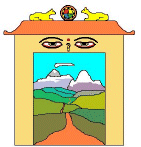
|
The Namche Conference: May 24-26,
2003 Participants and Presentations:
Ichiro Imai |
|
Ichiro Imai (Sanda city, Hyogo Prefecture, Japan) School of Policy Studies, Kwanseigakuin University; email: z00002@ksc.kwansei.ac.jp Abstract Natural Environment and Peoples Living in the "World Heritage" areas: Khumbu, Nepal and Shirakami, Japan The Sherpa society has joined up economically and socially with the other countries through mountaineering and trekking activities. Since 1953 when the top of Sagarmatha was reached first, a lot of people has been employed as guide, kitchen staff or porter of the trekking industry. With the results, the people have been making their living at the mountainous regions in all over Nepal. In 1979, the park was declared a World Heritage Site. Since that time, number of foreign visitors has increased sharply until now. Number of fireign tourists who enter into the area every year is much larger than that of the inhabitants of the area. Younger people of the Sherpa have gone out of the local area in order to be engaged themselves as worker of trekking industry. Agricultural and pastoral labourers become few in the local villages. People have emigrated from their native area to larger cities, such as Kathmandu. This depopulation is similar with the phenomenon which has proceeded in the local areas in Japan since World War II. People of Khumbu are apt to apart from life which closes to the natural environment of Himalaya. Environmental deterioration is getting for the worse, because a lot of outsiders entered into the limited narrow areas and they left the rubbish and excrement, so that the vegetation and physiognomy have been taken out. Although several works against the problems have begun to put, a satisfied fruit has never been born. The Shirakami mountains, northern Japan, was declared a World Heritage Site by UNESCO in 1993, and has been hold spotlight as a natural conservation area. A depopulation has also been grown in the society around the Shirakami as well as in the Sherpa society. At the same time, a dam is in the cource of re-construction. People of nearly 200 households are making move to the other places, because their houses are to be under water in near future. People are getting apart from life in the natural environment. Several inhabitants try to earn their living as guide for tourists in the forests. This trial deserves our attention because practice of eco-torism in which tourists enjoy touching with nature is highly appreciated in these days. However, we must notice that natural environments have been destroyed even on the occasion of eco-torism situation. It can be applied to the trekking in the Himalayas. In several local regions in Japan, similar trials have been practiced one after another. I cannot but fear of producing natural environment on commercial basis from the points of consevation of nature and sustainability of society in the area. When nature is only assessed at its commercial value, it would been destroyed easily. So that it is important to keep the nature in sustainable condition by both the local communuties and the administrations.
|
Email: info@namche.net
